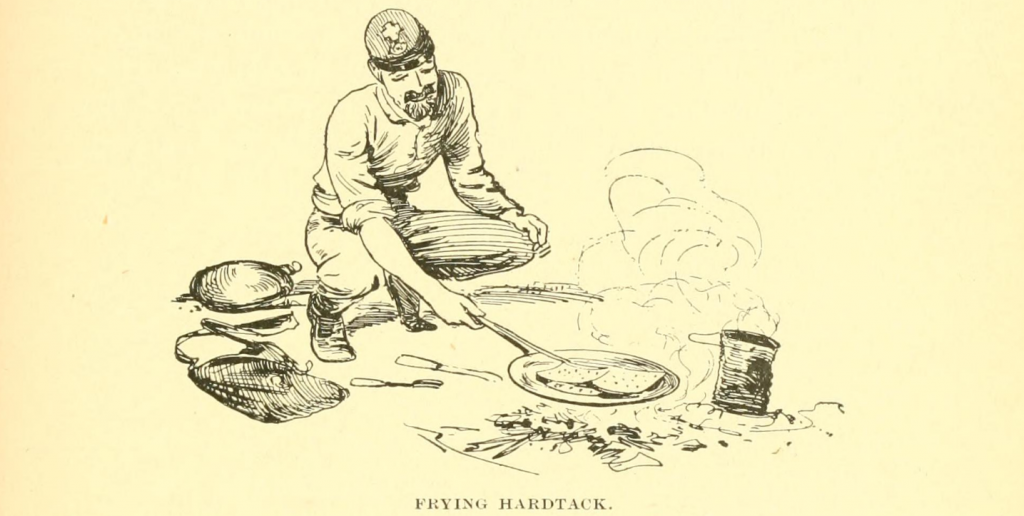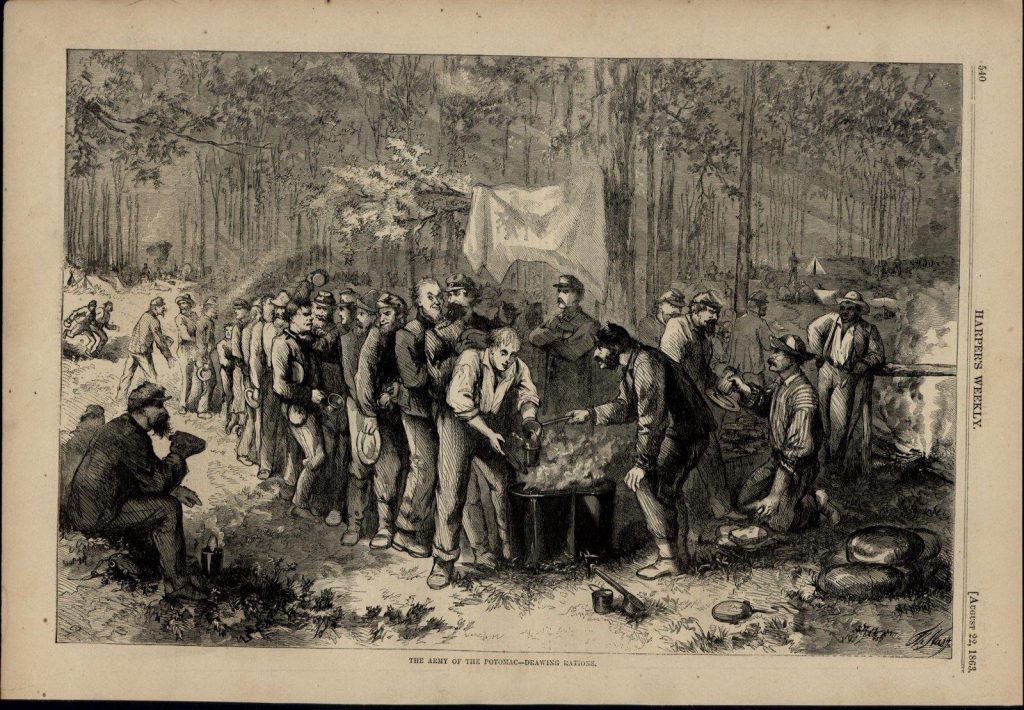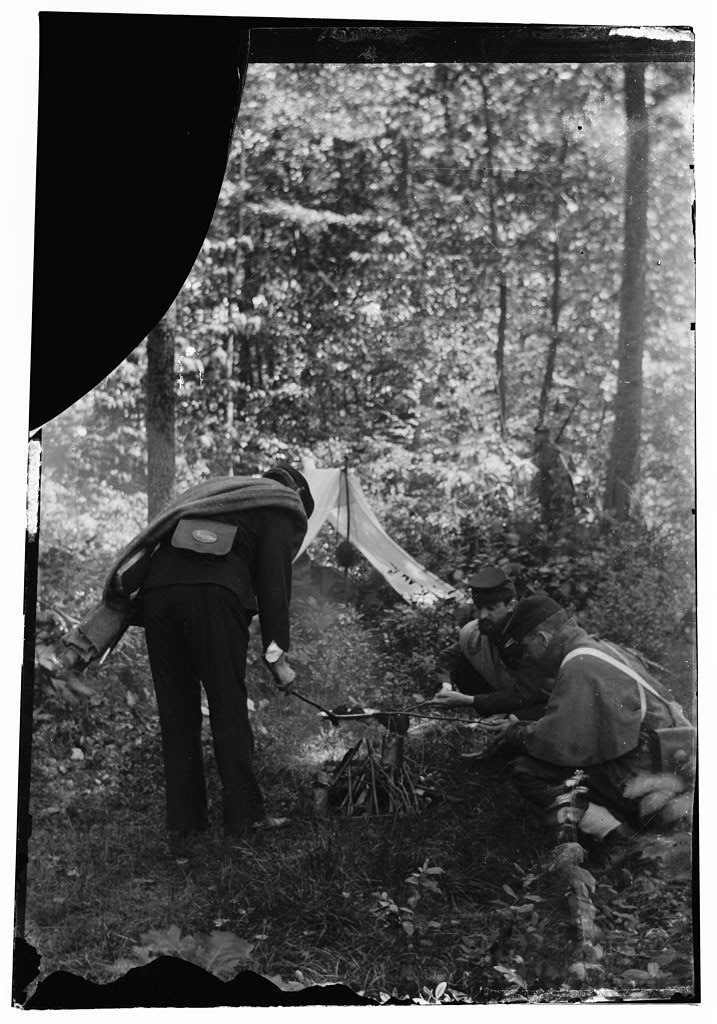Table of Contents
“Eat your vegetables.”
Parents use the phrase today in a desperate effort to get their children to eat something besides ice cream or french fries. During the Civil War though, such a request could literally be a life-saving suggestion.
Disease was responsible for more than two-thirds of all Civil War deaths. Diarrhea and dysentery was the most common reported disease during the conflict, with more than 1.6 million cases in the Union army alone. All told, it led to roughly 50,000 deaths on both sides.
Chronic diarrhea was often (but not always) a sign of malnutrition or critical vitamin deficiencies. When dealing with cases of diarrhea, Civil War surgeons were often close to properly diagnosing the problem, as they frequently associated diarrhea with scurvy – a disease caused by a vitamin C deficiency and widely acknowledged to be treatable with fresh produce. So why was this such a common problem among Civil War armies?
A soldier’s regular diet generally did not include fresh fruits or vegetables. Their diet consisted largely of salted meat (often pork), beans, coffee, and hardtack (6 parts flour, 1 part water – you can try it at home, but I don’t recommend it). While there were a few variations between a Union and Confederate soldier’s diet (Confederates typically had cornbread instead of hardtack for example) the basic nutritional value was roughly the same – poor.

The government had few viable ways of getting vegetables (and the important vitamins that came with them) into a soldier’s diet. Desiccated vegetables became an important tool in the arsenal of nutrition.
Originally designed to combat the problem of scurvy for men serving on the frontier before the Civil War, Congress passed a law providing for the creation of canned, compressed, and mixed vegetables called desiccated vegetables. The rations of desiccated vegetables supposedly contained string beans, turnips, carrots, beets, and onions which had been compressed into one inch by one foot rectangular bricks.
Soldiers would often refuse to eat the desiccated vegetables because they tasted so dreadful. Reactions like Sergeant Cyrus Boyd’s of the 15th Iowa were common: “I ate a lot of desiccated vegetables yesterday and they made me the sickest of my life. I shall never want any more such fodder.”[1] The horrid taste eventually helped desiccated vegetables earn the derisive nickname “desecrated vegetables” among the troops.
Despite the terrible taste, there were indeed vegetables in the cans, but the way in which soldiers were instructed to prepare them likely diminished the health benefits. They were encouraged to prepare the desiccated vegetables in a soup that took between one and three hours to make. Not only were many vitamins boiled out of the vegetables, but the long preparation time made it hopelessly impractical to prepare while an army was on the move.

Foraging (even when it was not allowed) was an important, if sporadic, means for soldiers to access fresh fruits and vegetables. It was not uncommon for soldiers to seek out fruits or vegetables as they passed or camped by local farms. In at least one recorded instance, General Lee encouraged his men to forage the surrounding countryside in the weeks leading up to a campaign so they would be in peak health.

It should be noted that Civil War surgeons understood fruits and vegetables were an important component for a healthy army. Medical authorities knew exactly what to prescribe in cases of scurvy. Scurvy had always been a problem for large armies on the move, which often required much more food than any one patch of land could provide. By the time of the Civil War, it was well known that supplying more fruits and vegetables for soldiers was an effective treatment for scurvy, even if surgeons did not know why it was effective. Such a prescription was less common in cases of diarrhea, but was frequently resorted to if the issue lingered for an extended period of time.
In 1863 Union surgeon Joseph Woodward published a study on camp diseases. His conclusion about diarrhea demonstrates that Civil War surgeons, despite often being stereotyped as ill-informed butchers, could form fairly sophisticated hypotheses based on data they collected. Woodward’s understanding of chronic diarrhea and its causes was strikingly accurate:
Originating chiefly among troops in camps, [diarrhea] evidently stands in some definite relationship to the usual conditions of camp life. Of these, it would appear most intimately connected with the diet, and this relationship is of such a kind that chronic diarrhea becomes more and more common and fatal as the constitutional manifestations which result from camp diet approach more and more to the condition of recognizable scurvy, a most important point to be considered in connection with the hygienic treatment of this disease. As a consequence it has more than once happened on a grand scale, during the present war, to see a sudden and palpable diminution in the amount of diarrhea follow the liberal issue of potatoes and onions to an army in which the tendency to scurvy was exhibiting itself in a manner too evident to be overlooked.[2]
Lack of fresh produce was usually a limiting factor in carrying out the recommended dietary treatments. To increase that supply, the Federal government frequently relied on the aid of private organizations like the United States Sanitary Commission.
Thankfully civilians on the home front knew the benefits of eating healthy, too. Getting vegetables to the front was as important as medicine and bandages, according to the Sanitary Commission. Occasionally they held fundraisers exclusively to pay for shipping vegetables to the frontlines. Activities at these events included parades of wagons filled with potatoes, cabbages, and beets. One campaign slogan captured the idea “Don’t send your sweetheart a love letter. Send him an onion.”[3]

Shipping vegetables to the troops became an important task for the Sanitary Commission. A lack of potatoes and onions nearly turned into an epidemic for Grant’s army laying siege to Vicksburg in late 1862. Upon hearing this, Mary Livermore of the Western Sanitary Commission (a separate but related entity to the main Sanitary Commission) resolved to marshal their resources to alleviate the dire shortage. Once they accumulated the necessary vegetables, they had to find a way to get them to the front since the roads were in such poor shape. Eventually Livermore convinced General Grant to provide boats to ship the produce if the women of aid societies would make sure the boats were manned. Thus the “potato fleet” was born.
In the end eating your vegetables was the most effective way to avoid the deadliest condition of the Civil War – diarrhea. It could fairly be stated then that if the soldiers had been able to eat more vegetables, Civil War armies would have been larger, healthier and more prepared to fight – and their mothers would have been happy.
Sources
[1] Taken from Alfred Bollet, Civil War Medicine: Challenges and Triumphs (Tucson: Galen Press Ltd, 2002), 337.
[2] Joseph Woodward, Outlines of the Chief Camp Diseases of the United States Armies as Observed during the Present War: A Practical Contribution to Military Medicine (Philadelphia: J.B. Lippincott, 1863), 253.
[3] Bollet, Civil War Medicine, 359.
About the Author
John Lustrea is a member of the Education Department and the Website Manager at the National Museum of Civil War Medicine. He earned his Master’s degree in Public History from the University of South Carolina. Lustrea has previously worked at Harpers Ferry National Historical Park during the summers of 2013-2016.



Leave a Reply
You must be logged in to post a comment.